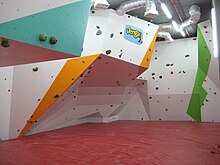
A climbing gym is a gym dedicated to indoor climbing. Climbing gyms have climbing walls that can be used for leading, top roping, and bouldering. They sometimes offer training equipment to improve technique, strength, and endurance.

A climbing gym is a gym dedicated to indoor climbing. Climbing gyms have climbing walls that can be used for leading, top roping, and bouldering. They sometimes offer training equipment to improve technique, strength, and endurance.
Different kinds of climbing gyms focus on various types of climbing, and their layout and equipment vary accordingly. [1]
A climbing wall is an artificial wall designed for climbing. Gyms dedicated to bouldering tend to have short routes without bolts, usually no more than 6 metres tall. Other gyms including or focused on sport climbing will include taller walls with bolts and quickdraws. Some climbing gyms may also include auto belays, which are motors designed to allow someone to climb without the assistance of a belayer. Some gyms may have a wall dedicated to speed climbing, in which case an auto belay will be used. [2] A climbing gym will often have walls of several different styles, including slab walls, overhangs, and vertical walls. Some climbing gyms include programmable climbing walls such as a moon board which allow users to set climbs using a fixed set of holds and upload them for other users to try. When a climber selects a climb to try, the relevant holds are lit up by LEDs.

Most climbs in a climbing gym (known as "problems" in bouldering [3] ) will have an approximate climbing grade [note 1] and a way of identifying the holds to be used. In some gyms, holds are identified by coloured tape placed next to each hold, but it is becoming more common for the holds of a given climb to all be the same or similar colour for easy identification. Climbs will usually have some method of identifying the "starting holds" (the holds you use to start the climb) such as tags or tape next to each starting hold. Although the practice is not universal, many gyms use a circuit system wherein climbs of a similar grade in a gym will be the same colour, will be reset at the same time, and sometimes will be set in a particular style.
Many climbing gyms will contain an area dedicated to training. This can include general physical fitness equipment, such as a bench, weights, or a Pullup bar, but can often include climbing-specific training equipment such as a campus board or hangboards. Climbing gyms often have equipment related to calisthenics and bodyweight training, including Resistance bands, dip belts, and rings.

Climbing gyms have a lot of equipment dedicated to climbing. Most gyms, regardless of the type of climbing they are designed for, will offer climbing shoes for rent. Climbing gyms that offer sport climbing will also offer harnesses, ropes, and belay devices. Some climbers may bring other equipment, such as chalk bags or liquid chalk. [5] Most climbing gyms offer rent of necessary equipment, and some have shops which allow the purchase of equipment. Other equipment which may be on offer includes finger tape or helmets.
Climbing is a dangerous sport which can cause many injuries. [6] To mitigate this, climbing gyms have equipment and precautions in place to ensure safety.
Safety policies are the practices and rules enforced by a climbing gym to ensure the safety of its climbers. This may include supervision, ensuring that unsupervised climbers have enough experience to keep themselves safe, or rules to dissuade dangerous behavior, such as walking under climbers or jumping from high bouldering walls. Climbing gyms often have lessons for people to learn climbing safety and technique.
Climbing gyms have equipment designed to keep people safe. This includes harnesses to avoid dangerous falls, padded floors around bouldering walls to soften landings, and extra holds designed to help people to climb down from the top of difficult climbs.
The first climbing holds and walls were designed for climbers to keep training during the winter. Early walls and holds evolved in the late 1970s and early 1980s from wood strips screwed to garage walls, glued rocks, and other improvisations. The first 'modern' molded plastic holds with a bolt in the middle were created by French climber François Savigny in 1983, sparking a nascent industry. The first facility that would be recognized as a climbing gym today was established in Seattle, Washington by climbers Rich Johnston and Dan Cauthorn in January 1987. The gym, called Vertical Club, was created with a $14,000 budget with the aid of the local community, by gluing rocks onto the walls. [7] [8]
Paraclimbing is a form of adaptive climbing that allows individuals with physical disabilities to enjoy the sport of rock climbing. [9] It involves using a variety of techniques and equipment modifications to accommodate different abilities, such as prosthetics, harnesses, and ropes. [10] Paraclimbing is a rapidly growing sport that is gaining recognition on a global scale and is now included in major climbing competitions, including the Paralympic Games. [11]
Paraclimbing is a sport that not only challenges physical limitations but also promotes mental strength and resilience. [9] Climbers are required to use their problem-solving skills to navigate various climbing routes, which can be mentally and physically demanding. [9] The sport has different categories based on the nature of the disability, including visual impairment, upper limb amputations, lower limb amputations, neurological impairment, autism, and intellectual impairment. [10]
Paraclimbing categories are based on the nature of the disability. [12] Here are the different categories of Paraclimbing:
Visually impaired: The visually impaired category is for climbers who have a visual impairment, including total blindness or partial vision loss [13] . Climbers in this category usually have a sighted partner who helps them navigate the climbing route [11] . The sighted partner communicates with the climber and provides information on the route's features, such as the location of hand and foot holds [11] . This category requires good communication and teamwork between the climber and their sighted partner [13] .
Upper limb amputee: This category is for climbers who have lost one or both arms or hands. [12] Climbers in this category use specialized prosthetics or adaptive equipment to climb. [12] The sighted partner communicates with the climber and provides information on the route's features, such as the location of hand and foot holds. [11] The sighted partner also helps ensure the climber's safety by guiding them towards the top of the route. [11]
Lower limb amputee: This category is for climbers who have lost one or both legs or feet. [12] Climbers in this category use specialized prosthetics or adaptive equipment to climb. [12] These prosthetics or adaptive equipment help the climber maintain their balance and stability while climbing. [11] Climbers in this category also use a technique known as "heel hooking," which involves using the heel of their prosthetic foot to hook onto a hold and maintain their balance. [12]
Neurological impairment: This category is for climbers with neurological conditions, including cerebral palsy, multiple sclerosis, and spinal cord injuries. [12] Depending on their specific condition, climbers may utilize adaptive equipment or rely on their upper body strength to climb [11]
Autism: The autism category is for climbers with autism spectrum disorder [13] . Climbers in this category may have difficulty with sensory processing and may require additional support and accommodation [11] . Climbers in this category require patience, understanding, and support to navigate the climbing route effectively [11] .
Intellectual impairment: This category is specifically designed for climbers who have intellectual disabilities. [12] Intellectual disabilities can encompass a wide range of cognitive impairments, which may affect an individual's ability to learn, reason, problem-solve, or adapt to new situations [13] . As a result, climbers in this category may face unique challenges while participating in paraclimbing. [12] To ensure a supportive and inclusive environment for climbers with intellectual disabilities, additional support and accommodations may be necessary to successfully navigate the climbing route. [13] This may include individualized coaching, tailored instructions, or the use of visual aids to help the climber understand and follow the route. [13]

Bouldering is a form of free climbing that is performed on small rock formations or artificial rock walls without the use of ropes or harnesses. While bouldering can be done without any equipment, most climbers use climbing shoes to help secure footholds, chalk to keep their hands dry and to provide a firmer grip, and bouldering mats to prevent injuries from falls. Unlike free solo climbing, which is also performed without ropes, bouldering problems are usually less than six metres (20 ft) tall. Traverses, which are a form of boulder problem, require the climber to climb horizontally from one end to another. Artificial climbing walls allow boulderers to climb indoors in areas without natural boulders. In addition, bouldering competitions take place in both indoor and outdoor settings.
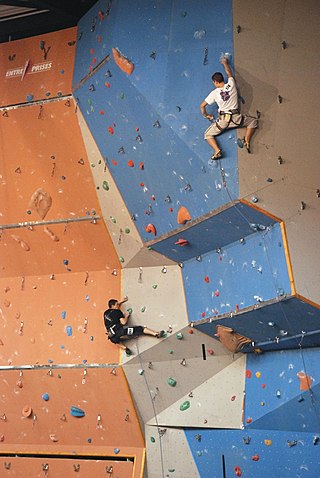
A climbing wall is an artificially constructed wall with grips for hands and feet, usually used for indoor climbing, but sometimes located outdoors. Some are brick or wooden constructions, but on most modern walls, the material most often used is a thick multiplex board with holes drilled into it. Recently, manufactured steel and aluminum have also been used. The wall may have places to attach belay ropes, but may also be used to practice lead climbing or bouldering.

In rock climbing, mountaineering, and other climbing disciplines, climbers give a grade to a climbing route or boulder problem, intended to describe concisely the difficulty and danger of climbing it. Different types of climbing each have their own grading systems, and many nationalities developed their own, distinctive grading systems.
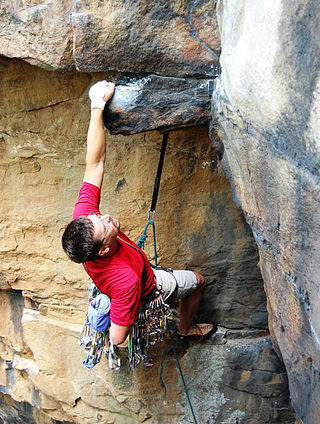
Traditional climbing is a type of free climbing in rock climbing where the lead climber places the protection equipment while ascending the climbing route; when the lead climber has completed the route, the second climber then removes the protection equipment as they climb the route. Traditional climbing differs from sport climbing where the protection equipment is already pre-drilled into the rock in the form of bolts.

Glossary of climbing terms relates to rock climbing, mountaineering, and to ice climbing.
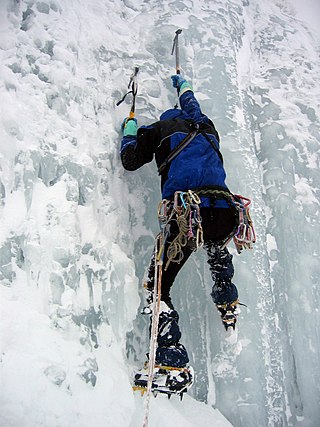
Ice climbing is the activity of ascending inclined ice formations. Usually, ice climbing refers to roped and protected climbing of features such as icefalls, frozen waterfalls, and cliffs and rock slabs covered with ice refrozen from flows of water.

Rock-climbing equipment requires a range of specialized sports equipment, for training, for aid climbing, and for free climbing. Developments in rock-climbing equipment played an important role in the history of rock climbing, enabling climbers to ascend more difficult climbing routes safely, and materially improving the strength, conditioning, and ability of climbers.

Free climbing is a form of rock climbing in which the climber can only use climbing equipment for climbing protection, but not as an aid to help in their progression in ascending the route. Free climbing therefore cannot use any of the tools that are used in aid climbing to help overcome the obstacles encountered while ascending a route. The development of free climbing was an important moment in the history of rock climbing, including the concept and definition of what determined a first free ascent of a route by a climber.

Aid climbing is a style of climbing in which standing on or pulling oneself up via devices attached to fixed or placed protection is used to make upward progress.

Sport climbing is a type of free climbing in rock climbing where the lead climber clips into pre-drilled permanent bolts for their protection while ascending the route. Sport climbing differs from the riskier traditional climbing where the lead climber has to insert temporary protection equipment while they are ascending.
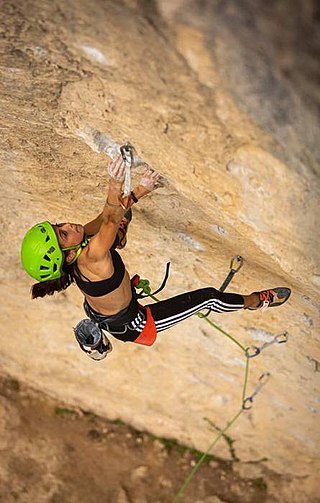
Lead climbing is a technique in rock climbing where the lead climber clips their rope to the climbing protection as they ascend the climbing route, while their second remains at the base of the route belaying the rope to protect the lead climber in the event that they fall. The term is used to distinguish between the two roles, and the greater effort and increased risk, of the role of the lead climber.

In rock climbing, a bolt is a permanent anchor fixed into a hole drilled in the rock as a form of climbing protection. Most bolts are either self-anchoring expansion bolts or fixed in place with liquid resin. Climbing routes that are bolted as known as sport climbs, and those that do not use bolts, are known as traditional climbs.

Rock climbing is a sport in which participants climb up, across, or down natural rock formations. The goal is to reach the summit of a formation or the endpoint of a usually pre-defined route without falling. Rock climbing is a physically and mentally demanding sport, one that often tests a climber's strength, endurance, agility and balance along with mental control. Knowledge of proper climbing techniques and the use of specialized climbing equipment is crucial for the safe completion of routes.

Competition climbing is a type of rock climbing held indoors on purpose-built artificial climbing walls, although earlier versions were held on external natural rock surfaces. The three standalone competition climbing disciplines are: lead climbing, bouldering, and speed climbing. A fourth discipline of "combined" is based on combinations of results in the three main disciplines. Competition climbing is sometimes called "sport climbing", which is the type of lead climbing performed in competition climbing.
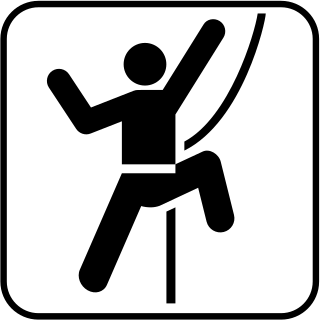
A route setter is a person who designs artificial rock climbing wall routes, or problems. Also known as "setters", these professionals combine technical craft with an artistic representation of real rock climbing moves. They do this with modular resin, polyurethane, polyester, fiberglass, or wood holds or "grips" that mimic real rock features. These routes are used by a rock climber to get to the top of a climbing wall.

The Paralympic sports comprise all the sports contested in the Summer and Winter Paralympic Games. As of 2020, the Summer Paralympics included 22 sports and 539 medal events, and the Winter Paralympics include 5 sports and disciplines and about 80 events. The number and kinds of events may change from one Paralympic Games to another.

Assistive technology in sport is an area of technology design that is growing. Assistive technology is the array of new devices created to enable sports enthusiasts who have disabilities to play. Assistive technology may be used in disabled sports, where an existing sport is modified to enable players with a disability to participate; or, assistive technology may be used to invent completely new sports with athletes with disabilities exclusively in mind.

Crack climbing is a type of rock climbing in which the climber follows a crack in the rock and uses specialized climbing techniques. The sizes of cracks vary from those that are just barely wide enough for the fingers to fit inside, to those that are so wide that the entire body can fit inside with all limbs outstretched. Many traditional climbing routes follow crack systems, as they provide natural opportunities for placing protective equipment.

Alpine climbing is a branch of climbing in which the primary aim is very often to reach the summit of a mountain. In order to do this high rock faces or pinnacles requiring several lengths of climbing rope must be ascended. Often mobile, intermediate climbing protection has to be used in addition to the pitons usually in place on the climbing routes.
Paraclimbing is competitive climbing for disabled athletes.